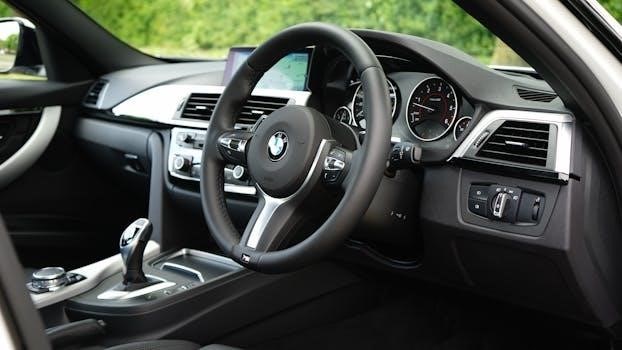The clutch on a 1950 3-speed manual transmission is vital for smooth gear changes and efficient power delivery. This guide provides steps for adjusting the clutch for optimal performance.

Understanding the Clutch System
The clutch system in a 1950’s vehicle facilitates disengagement of the engine from the transmission. This allows for gear shifting without grinding and smooth starts from a standstill‚ making driving possible.
Components of a typical 1950’s Clutch Linkage
A typical 1950’s clutch linkage consists of several key components that work together to engage and disengage the clutch. The clutch pedal‚ which is operated by the driver‚ initiates the process. A clutch rod connects the pedal to the clutch fork. The clutch fork pivots on a fulcrum and pushes against the throw-out bearing.
The throw-out bearing‚ also known as the clutch release bearing‚ presses against the clutch pressure plate. This action disengages the clutch disc from the flywheel‚ interrupting the power flow from the engine to the transmission. Springs within the pressure plate ensure consistent clamping force.
Adjustment mechanisms‚ typically located along the clutch rod‚ allow for fine-tuning the amount of free play in the pedal. This free play is essential to ensure full clutch engagement when the pedal is released and complete disengagement when depressed. The entire system relies on mechanical linkages for its functionality.
Identifying the Need for Clutch Adjustment
Recognizing the signs of a misadjusted clutch is essential. Common symptoms include difficulty shifting‚ clutch slippage‚ and unusual noises. Timely adjustment prevents further damage and ensures smooth operation.
Common Symptoms Indicating Clutch Adjustment Issues
Several telltale signs indicate that your 1950’s 3-speed manual transmission clutch needs adjustment. Difficulty shifting into gear‚ especially from a standstill‚ is a primary indicator. Grinding noises during gear changes‚ even with the clutch fully depressed‚ suggest incomplete disengagement.
Clutch slippage‚ noticeable as engine revs increasing without a corresponding increase in vehicle speed‚ particularly under load or uphill‚ points to adjustment needs. A high clutch pedal engagement point‚ close to the top of its travel‚ also signals potential issues. Conversely‚ a very low engagement point can indicate similar problems.
Unusual noises‚ such as whirring or chirping sounds when the clutch pedal is depressed‚ might suggest throw-out bearing issues related to improper clutch adjustment. A vibrating or pulsating clutch pedal can also signify problems needing attention. Regular checks for these symptoms will help maintain clutch health.

Tools and Materials Required
Before embarking on a clutch adjustment for your classic 1950’s 3-speed manual transmission‚ gather the necessary tools and materials. You’ll need a set of standard wrenches and sockets‚ typically including sizes relevant to your vehicle’s specific clutch linkage hardware. A pair of pliers can be useful for manipulating cotter pins or retaining clips.
A screwdriver‚ both flathead and Phillips head‚ may be required depending on the type of adjustment mechanism present. A ruler or measuring tape will help ensure accurate free play adjustment at the clutch pedal. Work gloves are essential for protecting your hands from dirt and sharp edges.
Penetrating oil can aid in loosening any rusted or stuck components within the clutch linkage. Wheel chocks are vital for safety‚ preventing the vehicle from rolling during the adjustment process. Finally‚ consult your vehicle’s service manual for specific torque specifications and diagrams relevant to your model.

Step-by-Step Adjustment Procedure
Follow these steps to adjust the clutch on your 1950 3-speed manual transmission. Ensure safety precautions are taken before beginning any adjustments to the clutch system.
Locating the Clutch Adjustment Rod
The first crucial step in adjusting the clutch of your 1950’s 3-speed manual transmission involves accurately locating the clutch adjustment rod. This rod is a key component in the clutch linkage system‚ and it directly influences the amount of free play in the clutch pedal. Typically‚ this rod can be found extending from the clutch fork to the pedal linkage‚ usually positioned beneath the vehicle or within the engine compartment‚ depending on the car’s design.
Consulting your vehicle’s repair manual is highly recommended to pinpoint the precise location of the clutch adjustment rod for your specific 1950 model. The manual will contain detailed diagrams and descriptions that will guide you to the rod. Look for a rod with a threaded end and a lock nut‚ which are characteristic of an adjustment mechanism.
Once located‚ carefully inspect the rod and its surrounding components for any signs of damage or wear. This initial inspection will help you identify any potential issues beyond a simple adjustment that may require further attention.
Adjusting Free Play at the Clutch Pedal
After locating the clutch adjustment rod‚ the next vital step is adjusting the free play at the clutch pedal. Free play refers to the amount of movement the clutch pedal has before it begins to engage the clutch. Proper free play ensures the clutch fully engages and disengages‚ preventing slippage and premature wear. Ideally‚ you want about 3/4 to 1 inch of free play at the top of the clutch pedal.
To adjust the free play‚ loosen the lock nut on the clutch adjustment rod. Then‚ turn the adjusting nut to either lengthen or shorten the rod. Lengthening the rod decreases free play‚ while shortening it increases free play. After each adjustment‚ tighten the lock nut to secure the rod’s position. It is important to ensure there is free play at the top of the pedal. This ensures that your clutch is fully engaged and there is no load on the throw out bearing.
Checking Clutch Engagement Point
Once the free play is adjusted‚ it’s crucial to check the clutch engagement point. The engagement point is where the clutch starts to grab as you release the pedal. It should engage roughly 1-1/2 inches from the floor.
To check‚ start the engine and slowly release the clutch pedal in first gear. Note where the car begins to move. If it engages too close to the floor‚ there may not be enough disengagement‚ which can cause difficulty shifting. If it engages too high‚ the clutch may be worn or not engaging fully.
If adjustment is needed‚ slightly adjust the rod until you have the proper engagement point. Remember‚ the center 4-5 inches of the pedal swing is the work part of the clutch. Make small adjustments and test drive after each one until optimal engagement is achieved.

Fine-Tuning the Clutch
After the initial clutch adjustment‚ fine-tuning is often necessary to achieve optimal performance. This involves making minor adjustments to the clutch linkage to ensure smooth engagement and disengagement.
Start by test driving the vehicle in various conditions. Pay close attention to how the clutch feels during acceleration‚ deceleration‚ and shifting. If you notice any issues‚ such as clutch slippage‚ difficulty shifting into gear‚ or a jerky engagement‚ further adjustments may be needed.
Make small adjustments to the clutch rod‚ typically no more than a quarter turn at a time. After each adjustment‚ test drive the vehicle again to assess the impact on clutch performance. The goal is to find the sweet spot where the clutch engages smoothly and provides optimal power transfer without any slippage or harshness.
Troubleshooting Common Issues After Adjustment
Even after careful adjustment‚ issues can arise. One common problem is clutch slippage‚ where the engine revs without a corresponding increase in vehicle speed. This indicates that the clutch disc isn’t fully engaging with the flywheel‚ often due to insufficient free play.
Conversely‚ difficulty shifting into gear‚ especially when the engine is running‚ suggests that the clutch isn’t fully disengaging. This can be caused by excessive free play‚ preventing the clutch disc from separating from the flywheel.
Another potential issue is a chattering or jerky clutch engagement. This may indicate contamination on the clutch disc‚ worn components‚ or improper adjustment. If these problems persist‚ re-inspect all connections‚ check the clutch cable’s condition‚ and ensure the throw-out bearing operates smoothly.
Maintenance Tips for Clutch Longevity
To prolong the life of your 1950’s clutch‚ avoid “riding” the clutch pedal‚ as this causes premature wear on the friction disc and throw-out bearing. Ensure proper lubrication of the clutch linkage to minimize friction and prevent binding. Regularly inspect and adjust the clutch free play to maintain correct engagement and disengagement.
When shifting gears‚ fully depress the clutch pedal to prevent grinding and damage to the transmission synchronizers. Use the correct grade of gear oil in the transmission to ensure smooth operation and reduce wear on internal components. Finally‚ address any clutch-related issues promptly to prevent further damage and costly repairs.
